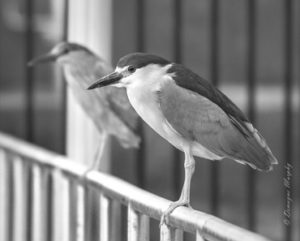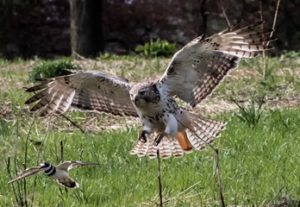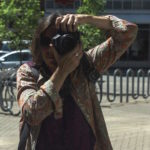In this fourth article (Part I) I’d like to address a more technical topic-that of shooting modes. In my first article I advised that you begin your photography journey in Program mode-the automatic mode that lets your camera choose your aperture, your shutter speed and your ISO setting; in other words the camera controls the exposure triangle. I recommended this because the exposure triangle can be confusing and overwhelming when we first begin-and often turns folks away from photography in my opinion. But as we advance we learn that artistic interpretation begins with controlling these factors ourselves.
So let’s talk briefly about the exposure triangle. Aperture is basically the size of the shutter opening in the lens that lets light onto the camera sensor (which records the image). It is similar to the pupil of your eye-which can open and close to allow a comfortable amount of light into your eye. This size is designated by an f number (or stop). f4, f5.6, f8, f11, f16 being the most common f numbers (or stops) used across brands/models. Counterintuitively, the smaller the f number the wider the shutter opening (f4 being a wider opening than f22).
The final effect of aperture on images is in Depth of Field-the area of the image that is sharp from front to back. The smaller the f number, the less depth of field. Less depth of field in portraiture (which is often what we are doing in wildlife photography) creates an effect called bokeh. Bokeh is the visually pleasing level of blurriness surrounding our central subject. Bokeh directs our attention to the main subject-the portrait of the bird.

F5.6 and 1/250, ISO 2000
This image illustrates the use of bokeh-a less distinct background that lends almost a painterly effect. This was purposeful and achieved with the smallest f stop my lens offers at this focal length.
Shutter speed is the length of time that your shutter remains open, allowing light to pass onto the sensor. Shutter speed is measured in seconds or fractions of seconds. 1/4 means a quarter of a second. 1/250 means one two hundred fiftieth of a second. 1/4 being a longer exposure than 1/250.
The final effect of shutter speed on images is motion blur. The faster the shutter speed the more likely that your camera can “freeze” the action of your subject-capture it in a sharp way. Slower shutter speeds are less able to freeze motion. There are certainly artistic reasons, even when photographing wildlife-for wanting to blur our subject. This can lead to appealing effects of motion and light. But more often than not we’d like to freeze a bird in action so that the image is sharp and clear. The image of the hawk below illustrates a shutter speed fast enough to freeze the action (1/1250) without blurring of the wings. This shutter speed was possible because there was sunlight available and because I increased my ISO to 1250. (The lack of absolute clarity was due to camera motion from not using a tripod-see my prior article on this site!! Though an exception to the tripod caveat ((seems like there’s always an exception in photography)) is that had I been carrying a tripod I would probably have missed the shot altogether. This scene exploded unexpectedly while I was walking by and I would not have had time to set the camera/tripod up. Wildlife photography seems to be a wonderful mix of absolute boredom at times opposed by fortuitous happenstance!)

f9 and 1/1250, ISO 1250
In this image, because I needed both the killdeer and the hawk to be in focus I needed to use a larger f stop (f9). Aperture here was my prime consideration because the magic of the photo was being able to see both birds clearly. Had the wings been slightly blurred due to the camera needing to choose a slower shutter speed (due to the higher f stop)I felt the image would still have worked.
To get correct exposure we are generally moving aperture and shutter speed in opposite directions. As we increase the opening of the lens-thereby letting in more light-the sensor requires that we shorten the shutter speed. Otherwise we would overexpose the image-too wide of an opening combined with too long of an exposure time—in both cases letting a lot of light hit the sensor for too long.
ISO is a standardized (across brands/models) designation for how sensitive the sensor is to light-similar to the old film speeds. Some folks think of it as the “light balancer”. In other words, most of us think of correct exposure firstly in terms of aperture and shutter speed and only lastly use ISO to balance out an exposure if need be. Base ISO is typically 100-that being the least sensitive. This number can increase dramatically however on most digital cameras-as high as 12000 or even higher. Higher ISO numbers allow for smaller lens openings (higher f numbers) or for shorter shutter speeds.
The final effect of ISO level on images is unfortunately that of digital noise. This is actually distortion of the image that looks like specks or graininess. The higher the ISO the more digital noise we get. Determining how much noise your camera creates at various ISO levels is primarily just trial and error. Many cameras can easily handle ISO levels up to 1600. Test your camera out to determine its limitations.
So exposure is always a compromise between these three elements of the exposure triangle-there are constraints to each of them and we often have to decide which element is the most important to our image.
So where does this take us in terms of shooting modes? Our choices are aperture priority, shutter priority or fully manual. Aperture priority (designated on your top dial as Av or A on Nikon) allows the user to choose the aperture desired and then the camera makes the correct exposure by choosing the shutter speed for you. Shutter priority (designated as Tv in Canon and S in Nikon) allows the user to choose the shutter speed and then makes the correct exposure by choosing the aperture for you. Manual mode (designated as M) requires you to choose both aperture and shutter speed, which can be very difficult during times of unpredictable motion of your subject.
My experience has been that wildlife photographers use Aperture priority the most often. This is not to say that Shutter priority or Manual are never used-as there are certainly scenarios that call for these modes. But my experience has been that especially as beginners we can safely use Aperture priority for most of our shooting. Why is this?
When sunlight is plentiful I think the easiest (and quickest way in the field) to achieve correct exposure is to shoot in Aperture priority mode. The camera only requires one input from you and this number can be changed quickly if your subject or conditions change. Also, because I like portrait bokeh the first thing I think about is what f number do I need in order to keep the bird sharp but the background blurred. Again, the smaller the f number the less foreground to background sharpness we get. On my 100-400mm zoom lens my smallest f number is f4.5-and I have usually found this number to be perfect for the smaller songbirds (warblers, sparrows etc). As my subject gets larger-say a duck-I then increase my f number-maybe to f8.
The other advantage to starting with the largest shutter opening that suits my subject (the smallest f number) is that the larger the lens opening the faster my shutter speed which is critical for birds that are moving. Remember, if I pick a large aperture then my camera will move shutter speed in the opposite direction-choosing a faster shutter speed-to balance out the amount of light hitting the sensor.
Additionally, because your camera is more limited in f number options than it is in shutter speed I find it best to control aperture first. f4 or f5.6 may be the largest apertures available to me with the lens I am using-and I am often choosing this max so that firstly I can get faster shutter speeds and secondly to get the bokeh I want. I simply do not have the option to open the lens any wider. But many digital cameras have shutter speed options from 30 seconds to 1/8000 of a second-a huge range to choose from. Also, an image can generally tolerate faster shutter speeds than strictly needed. In other words I can choose f4.5 because of the bokeh I want and the camera may choose a shutter speed of 1/500 or it may choose 1/750-either being fine if I don’t have too much subject motion. As long as 1/500 is enough to stop the action I really cannot tell the difference in the final image between 1/500 and 1/750, whereas with a small bird I can see the difference in bokeh between f4 and f5.6.
Finally what action should we take in terms of our final variable-that of ISO? We will continue this topic in Part II of this article where we’ll talk about Auto-ISO and Exposure Compensation to finish off our discussion of shooting modes. But in the meantime to get started with Aperture priority mode I would suggest one of two ISO settings. If you are shooting with plenty of available light you can probably leave ISO set to base which is most likely 100 on your camera. If available light is poor or you are moving between well-lit and badly lit conditions you will have better results using Auto ISO (letting the camera select the ISO number). Either of these ISO options frees you from having to consider this third variable much while you are shooting right now.
Using Aperture priority will let you experiment with bokeh and portraiture in a way that Program mode did not allow. See what you like. Do you prefer lots of bokeh or would you rather see plenty of sharpness throughout the whole image plane? It’s totally up to you and this mode will let you explore that. See you out there!
by Demayne Murphy

